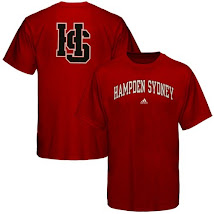"The Game" Video!
NBC Sports Article - November 2010
There's a digital clock in the football offices on the Randolph-Macon campus, one that has spent the past year slowly subtracting every day, every hour and every minute. It started its annual countdown last November after The Game, after the four mud-caked quarters that ended the Yellow Jackets' season. When it flashes a row of digital zeroes on Saturday, that means it's time — finally — for The Game again, for another chance at Hampden-Sydney.
The Game — capital T, capital G — between Randolph-Macon and Hampden-Sydney is billed as The Oldest Small School Rivalry in the South, but that’s a few more adjectives than it needs. The two Division III colleges are small in enrollment and name recognition, but their rivalry is bigger than some of those with more familiar-looking mascots.
Their Virginia-based backstory started 117 years ago, before Ohio State played Michigan in their own capitalized Game, before Texas and Oklahoma shot holes in the Red River and way before Georgia crashed Florida’s cocktail party.
America's most hyphenated matchup began Nov. 13, 1893, when a better-prepared Randolph-Macon squad beat the Hampden-Sydney Tigers 12-6. The players didn't wear helmets, the ball was largely round and the forward pass didn't exist — but neither did antibiotics, electric appliances or the state of Arizona. After last year's rain-soaked 34-27 win, Hampden-Sydney (8-1) leads the series 59-45-11.
Saturday will be the first time since 2007 that the matchup doesn't decide the Old Dominion Athletic Conference (ODAC) champion, but both head coaches agree that nothing — not the ODAC standings, not the season records — matters more than The Game.
"I've been here 11 years and it didn't take me long to realize that you can go 9-1 and lose to Macon and it's a bad year, and you can go 1-9 and beat them and it's a good year," said Hampden-Sydney coach Marty Favret.
"This game can make your season," echoed Randolph-Macon coach Pedro Arruza. "We're 7-2. We lost our starting quarterback [Oct. 16, at Washington & Lee]. Saturday is a big chance for redemption."
Like many long-standing athletic rivalries and an equal amount of first marriages, just being close together was enough to eventually fuel their hatred. The two schools are both located in the middle of Virginia's meaty right side, separated by 78 miles of highway and 55 years of history. The all-male Hampden-Sydney was founded in 1775, making it the 10th oldest college in the country. To them, Randolph-Macon — established 1830 — still has that new-college smell.
It took six decades and one academic sanction before they had the chance to face each other on the field. As John Brinkley notes in his hippopotamus-sized history of Hampden-Sydney, in 1892 the college president banned the football team from traveling to away games because "travel brings (students) into vicious temptations and surroundings." The next year, Randolph-Macon was one of the few squads willing to play the Tigers on their own campus, even though they couldn't reciprocate.
Since then each school's incoming and outgoing classes have managed to keep the "i" in animosity, no matter what date is "calligraphed" on their diplomas.
"My first night on campus, I talked to a guy who was in the Class of 1940 and he immediately talked about his four years against Randolph-Macon," Favret recalled. "1940! We're talking before World War II."
Other than The Game, the schools' biggest competition is for territory as they wrestle each other for an often-overlapping list of recruits, especially those from nearby Richmond. Of the combined 200 men on their rosters, 155 are from Virginia, which means players who were rivals (or teammates) during their high school careers might face each other for another four years.
"I was recruited pretty hard by Macon," Hampden-Sydney quarterback and Richmond native Travis Lane admits. "But it didn't come down to anything negative or that I didn't like about Macon. When I came here, I just knew that it was home."
"We probably lock horns with them on 75 percent of the kids we look at," Favret said. "They're looking at the same kinds of kids and they're very aggressive, so we tend to trip over them on a lot of guys."
On Saturday, each team will dress close to 100 players, a tenth of Hampden-Sydney's 1,060 students and a sixth of the male population at Randolph-Macon. For the teams' combined 44 seniors, The Game at Hampden-Sydney could be their last four quarters of football. In the past decade, only eight D-III players have been drafted by the NFL; there are currently seven D-III players listed on active NFL rosters. "Basically everyone's just playing because they really love the game," Lane said.
"Our guys do everything the Division I players do — the practices, the conditioning, the film study," Arruza said. "But the guys who choose to come to Macon play football to enhance their experience. It's not the whole experience."
Both coaches were quick to stress the importance of academics over athletics, and the only statistic they mentioned was their team's graduation rate. "If you're (on the team) as a junior or a senior, you're going to graduate," said Arruza. "In my time here, our graduation rate is 100 percent." Favret uses his graduation rate as a recruiting tool; 150 of the 153 four-year players he's coached have earned their diplomas.
The players — and alumni — from both schools would bristle at the suggestion that their teams are alike, that any similarities exist beneath their jerseys. It's true, though. The two programs have been built by and are led by coaches who believe in the fundamentals — not of offense or defense, but the fundamentals of being an honorable man.
"It doesn’t matter how well you play football. If you don't have the morals or the character and you're not dedicated to the academic aspects of this school, we're not taking the chance," Arruza said. "Because I will judge my success as a coach by what these guys are doing in ten or 15 years. Are you a good father? Do you treat your wife the right way? If so, then I've done my job."
Subscribe to:
Comments (Atom)



